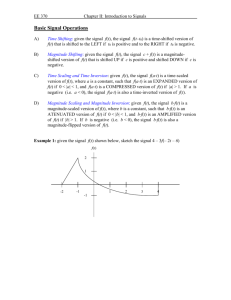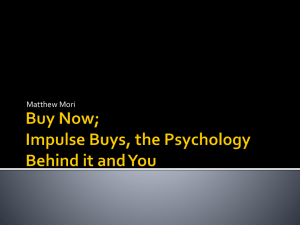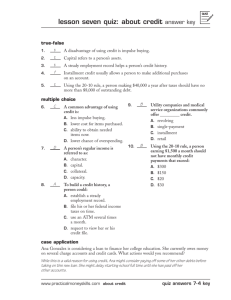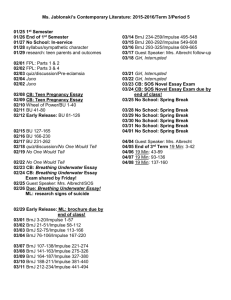Research Paper Management Impulse Purchase
advertisement
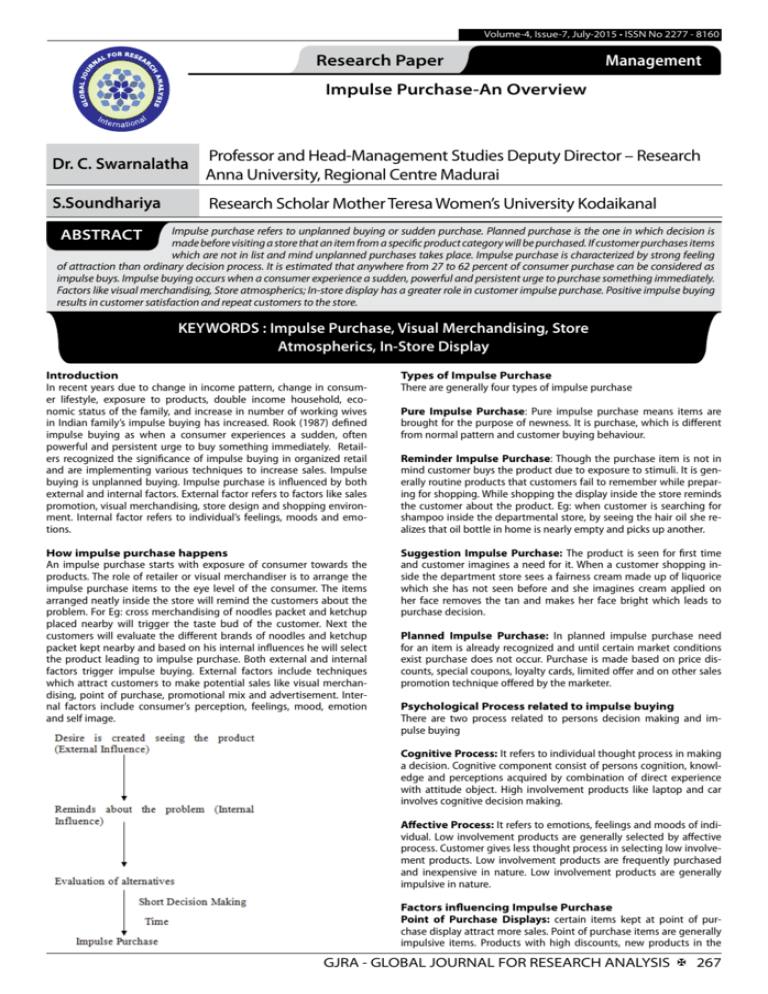
Volume-4, Issue-7, July-2015 • ISSN No 2277 - 8160 Research Paper Management Impulse Purchase-An Overview Dr. C. Swarnalatha Professor and Head-Management Studies Deputy Director – Research Anna University, Regional Centre Madurai S.Soundhariya Research Scholar Mother Teresa Women’s University Kodaikanal Impulse purchase refers to unplanned buying or sudden purchase. Planned purchase is the one in which decision is made before visiting a store that an item from a specific product category will be purchased. If customer purchases items which are not in list and mind unplanned purchases takes place. Impulse purchase is characterized by strong feeling of attraction than ordinary decision process. It is estimated that anywhere from 27 to 62 percent of consumer purchase can be considered as impulse buys. Impulse buying occurs when a consumer experience a sudden, powerful and persistent urge to purchase something immediately. Factors like visual merchandising, Store atmospherics; In-store display has a greater role in customer impulse purchase. Positive impulse buying results in customer satisfaction and repeat customers to the store. ABSTRACT KEYWORDS : Impulse Purchase, Visual Merchandising, Store Atmospherics, In-Store Display Introduction In recent years due to change in income pattern, change in consumer lifestyle, exposure to products, double income household, economic status of the family, and increase in number of working wives in Indian family’s impulse buying has increased. Rook (1987) defined impulse buying as when a consumer experiences a sudden, often powerful and persistent urge to buy something immediately. Retailers recognized the significance of impulse buying in organized retail and are implementing various techniques to increase sales. Impulse buying is unplanned buying. Impulse purchase is influenced by both external and internal factors. External factor refers to factors like sales promotion, visual merchandising, store design and shopping environment. Internal factor refers to individual’s feelings, moods and emotions. Types of Impulse Purchase There are generally four types of impulse purchase How impulse purchase happens An impulse purchase starts with exposure of consumer towards the products. The role of retailer or visual merchandiser is to arrange the impulse purchase items to the eye level of the consumer. The items arranged neatly inside the store will remind the customers about the problem. For Eg: cross merchandising of noodles packet and ketchup placed nearby will trigger the taste bud of the customer. Next the customers will evaluate the different brands of noodles and ketchup packet kept nearby and based on his internal influences he will select the product leading to impulse purchase. Both external and internal factors trigger impulse buying. External factors include techniques which attract customers to make potential sales like visual merchandising, point of purchase, promotional mix and advertisement. Internal factors include consumer’s perception, feelings, mood, emotion and self image. Suggestion Impulse Purchase: The product is seen for first time and customer imagines a need for it. When a customer shopping inside the department store sees a fairness cream made up of liquorice which she has not seen before and she imagines cream applied on her face removes the tan and makes her face bright which leads to purchase decision. Pure Impulse Purchase: Pure impulse purchase means items are brought for the purpose of newness. It is purchase, which is different from normal pattern and customer buying behaviour. Reminder Impulse Purchase: Though the purchase item is not in mind customer buys the product due to exposure to stimuli. It is generally routine products that customers fail to remember while preparing for shopping. While shopping the display inside the store reminds the customer about the product. Eg: when customer is searching for shampoo inside the departmental store, by seeing the hair oil she realizes that oil bottle in home is nearly empty and picks up another. Planned Impulse Purchase: In planned impulse purchase need for an item is already recognized and until certain market conditions exist purchase does not occur. Purchase is made based on price discounts, special coupons, loyalty cards, limited offer and on other sales promotion technique offered by the marketer. Psychological Process related to impulse buying There are two process related to persons decision making and impulse buying Cognitive Process: It refers to individual thought process in making a decision. Cognitive component consist of persons cognition, knowledge and perceptions acquired by combination of direct experience with attitude object. High involvement products like laptop and car involves cognitive decision making. Affective Process: It refers to emotions, feelings and moods of individual. Low involvement products are generally selected by affective process. Customer gives less thought process in selecting low involvement products. Low involvement products are frequently purchased and inexpensive in nature. Low involvement products are generally impulsive in nature. Factors influencing Impulse Purchase Point of Purchase Displays: certain items kept at point of purchase display attract more sales. Point of purchase items are generally impulsive items. Products with high discounts, new products in the GJRA - GLOBAL JOURNAL FOR RESEARCH ANALYSIS X 267 Volume-4, Issue-7, July-2015 • ISSN No 2277 - 8160 market, candies, cosmetics and cola items are kept at point of purchase display. Teenagers and ladies select cosmetics and kids select chocolate at point of purchase display. Store Atmospherics: Store Atmospherics is the combination of factors like equipment and fixture, public areas, physical facilities, shopping assisting material, ambient factors and window display. In recent researches it is found out those ambient factors has positive impact on customer buying behaviour. Ambient factors are the element that cannot be seen directly but can be felt by the customers. These factors affect the sub-conscious level of customers and alter the customer buying behaviour. It includes temperature, ventilation, sound, scent, cleanliness and brightness. Store design: The design of the store both interior and exterior draws more customers inside the store. The internal and external design of the store must communicate the image store wants to reflect to the general public. Good store design converts shoppers into customers and projects good store image in the minds of the customers. Visual merchandiser has a great role in arranging the store according to customer taste and preference to encourage impulse sales in the store. Visual Merchandising: visual merchandising is the external motivator and powerful tool to drive impulse purchase. Visual merchandising refers to presentation of store and its merchandise in a colour co-ordinated and attractive manner to drive more sales. Visual merchandising creates positive impact on the customers mind and drives more impulse purchases. Youngsters are more attracted to visual merchandising display and they make purchases impulsively. Customer likes to stay in a store with good visual display and good store ambience. More the customers stay inside the store; more purchases will be made by them. Sales Promotion: Techniques used to gear up the sales is called sales promotion techniques. Certain sales promotion techniques induce impulse purchase. Customers will have certain products in mind but will be waiting for price reductions. Cosmetic products like Avon and Oriflame gives monthly discounts for certain products alone. Teenage girls will be waiting for offers for products like lip balm and when the company gives offers up to 30%-40% in a particular month they do impulse purchase. Price reductions, buy one get one free, money back challenge has positive impact on customer buying behaviour. Sales People: Sales people are the important social factor in the store environment because they represent the store and are in direct contact with the customers. Sales person should have proper product knowledge. Improper product knowledge of the sales person leads to customer dissatisfaction. After entering the retail outlet customer consider sales people as the opinion leader to guide them in making decisions inside the store. Good service inside the store by sales people leads to high impulse purchase. Conclusion In this current competitive world it is necessary for the marketers to implement techniques to differentiate their products and services which leads to customer unplanned purchase. Retailers are in extreme pressure to ensure profitability and they strive hard to present their store in appealing manner to the target audience. Marketers are concentrating more on young generations because large disposable income in their hands makes them to purchase on the spot than the adults. Youngsters are inclined towards innovative and creative products. Youngsters like to purchase in the environment which presents feast to their eyes. External factors like visual merchandising and instore stimuli trigger their impulse buying. In-Store Shopping Environment: The environment created inside the retail outlet is most important factor for the customers to make buying decisions. Neatness and cleanliness of the store, attractive and elegant display, musical environment, trained staff, sales promotion strategy and pricing plays a great role in customer purchase decision process. In-Store Displays: Retailers provide good in-store display after understanding the customers well. Retailers use some strategies to make the customers do impulse purchase. Retailers place the popular products at the end of the store, so that customers walk through the store viewing all the products before getting the target product which leads to impulse sales. Another strategy is customers place new items near the common products which are usually in the customers shopping list. Good in store displays helps the customer in both planned and unplanned purchase. Shelving Techniques : The items are arranged in the store according to the planogram of the store. Top brands are generally kept at top shelves. The best selling brands are placed in bull’s eye zone. Bull’s eye zone refers to the area of reach of customer’s eye. It is generally second and third shelves from the top. Kids item are placed in bottom shelves. Products in all the shelves do not draw attention. Products at reach or eye level draws more impulse purchase. Competitive brands are placed nearby each other to draw more purchase. REFERENCES • Wayne D. Hoyer, Deborah J. Maclnnis,(1999). Consumer Behaviour. First Edition. Delhi: Houghton Macinnis. | • Jay. D. Lindquist , M.Joseph Sirgin (2003). Shopper Buyer and Consumer Behaviour. Second Edition . New Delhi: Bizantara. | • Parmar Vishnu, Ahmed Rizwan Raheem (2013), “ Factors influencing impulse buying behaviour”, European journal of scientific research, vol.100 (3). | • Dong Jenn Yang, Kuang Chuan Huang, Xuan Xiaoqing Feng (2011), “ A study of factors that affect the impulsive cosmetics buying of female consumers in Kaohsiung”, International journal of business and social science, Vol.2(24). | • Meysam Moayery, Samar Zamani, Hosein Vazifehdoost (2014), “ Effect of visual merchandising on apparel impulse buying behaviours among young adult females”, Indian journal of science and technology, Vol.7 (3), 360-366. | • Sujata Khandai, Bhawana Agarwal and Anju Gulla (2012), “Visual merchandising as an antecedent to impulse buying : An Indian perspective”, International Journal of Business and Management Studies, 267-275. | • Neha P. Mehta,Pawan K. Chugan (2013), “ The impact of visual merchandising on impulse buying behaviour of consumer : A case study from central mall of Ahmedabad”, Universal Journal of Management, Vol 1 (2) : 76-82. | • Xu, Y. (2007), “Impact of Store Environment on Adult Generation Y Consumers’ Impulse Buying. Journal of Shopping Center Research, 14(1), 39-56. | • http://blog.tiptaplab.com/Psychologyof-Impulse-Buying | • http://www.itc.polyu.edu.hk/UserFiles/access/Files/BA/FYP1314/14090/11333327D.pdf | • http://www.sibm.edu/FacultyResearch/pdf/samvad8/impulse.pdf | • http://www.vigin.com/entrepreneur/psychology-impulse-purchase | • http://www.business GJRA - GLOBAL JOURNAL FOR RESEARCH ANALYSIS X 268

